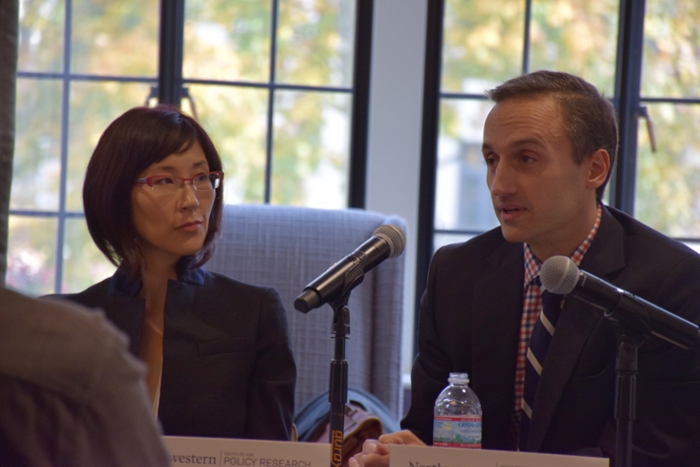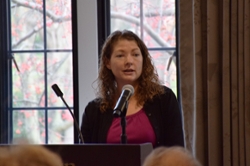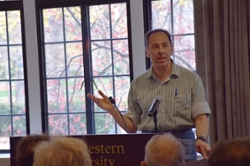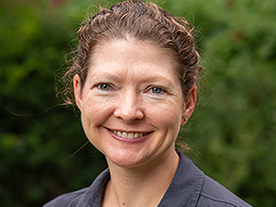Policy Implications of the 2016 Election
IPR experts address pressing issues post-election
Get all our news
Public support for the next administration’s agenda is clearly energized by anti-immigrant rhetoric. Stoking or extinguishing this will continue to be a very policy-relevant focus from all sides in the immigration battles ahead.””
Julie Lee Merseth
Political science professor and IPR associate

IPR's Julie Lee Merseth and UIC's Anthony LoSasso were two of the four experts who discussed the policy implications of the presidential election on November 14.
“In many ways it was an extraordinary campaign and election,” said IPR political scientist James Druckman in introducing IPR’s 2016 post-election panel on November 14. “Trump will be our first president with neither public office or military experience, and it’s only the fifth time in our history that the Electoral College winner did not win the popular vote.”
“At the same time, the election was not as unusual as many people think,” he continued, pointing to how negative campaigning dates back centuries and how people generally voted with their party—early exit poll analyses suggest Clinton won 89 percent of the vote among Democrats and Trump won 90 percent among Republicans.
According to Druckman, who introduced the event’s panelists to the more than 120 guests in attendance, “The more pressing question is: What does this election...mean for the future of political parties, the Supreme Court, and public policy?”
Through presentations on bipartisanship, the Supreme Court, healthcare, and immigration, the event’s four expert panelists dove deep into the policy implications of the 2016 election—all the while underscoring the future’s unknowns.
Bipartisanship | Supreme Court | Healthcare | Immigration
(Bi)partisanship in the 115th Congress
Prospects for bipartisanship in the new 115th Congress are dim, IPR political scientist Laurel Harbridge Yong predicted, although she does not think there is a “clear-cut story” either of Republicans enacting a “broad sweeping conservative agenda.”

Drawing from her research on congressional bipartisanship since the 1970s, Harbridge Yong noted that the usual conditions for the two parties to work together will be largely absent in the upcoming Congress. Factors that might promote bipartisanship include divisions between constituents and party aims (within a party) and divided government where different parties control different branches.
With Republicans in control of both the House and Senate, as well as the presidency, and Democrats gearing up to fight the majority, “we’re not likely to see a lot of bipartisanship,” she said.
There are also many unknowns right now, she pointed out. There are internal divisions within the Republican Party—between House Speaker Paul Ryan and the House Freedom Caucus and perhaps between President-Elect Donald Trump and Republican establishment figures such as Ryan and Senate Majority Leader Mitch McConnell over foreign policy, immigration, repeal of the Affordable Care Act, and infrastructure investment.
The fate of the Senate filibuster is also yet to be determined, Harbridge Yong said. Will the Democrats use it? Will the Republicans want to end its use? Or, she suggested, might some Republicans welcome Democrats blocking certain appointments or legislation they are opposed to?
Ultimately, we should not expect much bipartisanship in the new Congress. “There are very few of the traditional incentives or factors that would produce that,” she concluded.
The Supreme Court in 2016 and Beyond
“The short story with the Supreme Court is ‘I don’t know what’s going to happen,’” began Andrew Koppelman, who is John Paul Stevens Professor of Law at Northwestern.
“The President comes in with an empty seat on the Supreme Court that needs to be filled,” he continued, but it is quite possible that President-Elect Trump could end up filling more than just one seat during his presidency if any sitting justice were to retire in the next four years, which is a possibility for at least four current justices.

The most pressing question, then, is not whether Trump will fill a Supreme Court seat during his presidency, but rather what type of judge he will choose to appoint.
As Koppelman explained, during the presidential campaign Trump chose to “delegate the job of coming up with a list of nominees to the Heritage Foundation and the Federalist Society” rather than compiling his own list.
The list generated by these two organizations, according to Koppelman, is full of “familiar constitutional conservatives,” or judges that might be expected from any other Republican president today.
This, however, is not to say that there are not important differences within the Republican Party and between the judges on the list.
In fact, Koppelman highlighted one “fundamental cleavage”: While some of the proposed judges believe in judicial restraint—the idea that the Supreme Court should not second-guess the role of the legislature—others on the list have a more active, “libertarian” view of the constitution that makes them more inclined toward striking down legislative actions.
This cleavage is something that President-Elect Trump should keep in mind when deciding whom to appoint, Koppelman concluded, since the judge he nominates might soon either uphold or oppose legislation proposed during his presidency.
Can Trump Afford to Repeal the Affordable Care Act?
On the night of the election, healthcare economist Anthony LoSasso of the University of Illinois at Chicago first thought he would discuss a public option for the Affordable Care Act (ACA) as part of the panel. But as the election results rolled in, “the world kind of fundamentally shifted,” he said.
LoSasso pointed to more than 50 Republican attempts at repealing the ACA since it was passed in 2010, all of which were vetoed. But now, “the consequences of repealing the ACA have become much more real,” he said.
While on the campaign trail, Donald Trump stated repeatedly his intent to immediately “repeal and replace” Obamacare. Now that he has been elected, however, the president-elect might find that much more difficult to do, LoSasso said.
Since the ACA was enacted, more than 20 million Americans have received coverage under it. A repeal would lead to a large “backslide” in the number of uninsured, potentially angering voters.
“So I don’t know if a straight-up repeal will be done,” LoSasso said, noting the Republicans might be content to only change certain aspects—for example, rolling back the Medicaid eligibility expansion embedded in the ACA.
If they did, LoSasso said, they might opt to replace the expansion with Medicaid block grants to states—an idea perennially favored by Republicans, including Paul Ryan. This would essentially create 50 state laboratory experiments and constitute a significant change in how Medicaid is run, he continued.
It would also likely foster a push from traditional government-run Medicare to the Medicare Advantage program, which consists of plans administered by private insurance companies but paid for by the government.
In terms of two of the ACA’s most popular features, its pre-existing conditions provision and the ability for young adults to remain on their parents’ insurance until age 26, LoSasso pointed to Trump’s quick post-election pivot to retain them. But the question becomes how to pay for them, especially if the individual mandate is rescinded.
Immigration Rhetoric and Policy
Political scientist and IPR associate Julie Lee Merseth opened by discussing the impact of Trump’s campaign on the immigration debate.
“This election marks a critical shift in contemporary immigration discourse: the national mainstreaming of anti-immigrant rhetoric,” Merseth said. “[Trump] not only capitalized on existing fears and anxieties about immigration, he decidedly and brazenly escalated them.”
Merseth said negative perceptions of immigrants were a “defining feature” of Trump’s campaign, noting he framed immigrants as economic and national security threats, linking them with criminality and anti-Americanness.
What can we expect Trump’s administration to do about immigration? Merseth noted Trump’s top adviser on immigration, Kris Kobach, is the architect of Arizona’s SB 1070, a bill that required local law enforcement to check immigration status based on “reasonable suspicion”—which Merseth said led to racial profiling.
As a candidate, Trump promised to deport all illegal immigrants and to stop accepting Muslim immigrants to the United States. But as president-elect, Trump has provided different messages, making it difficult to forecast which policies he will even propose, Merseth said.
What is clear is that Trump will reverse Obama’s executive action protecting undocumented immigrants and will pour resources into U.S. Immigration and Customs Enforcement (ICE) and border control, according to Merseth.
“Public support for the next administration’s agenda is clearly energized by anti-immigrant rhetoric,” Merseth said. “Stoking or extinguishing this will continue to be a very policy-relevant focus from all sides in the immigration battles ahead.”
James Druckman is the Payson S. Wild Professor of Political Science and an IPR fellow. Laurel Harbridge Yong is associate professor of political science and an IPR fellow. Andrew Koppelman is the John Paul Stevens Professor of Law at Northwestern's Pritzker School of Law. Anthony LoSasso is professor of health policy and administration at the University of Illinois at Chicago. Julie Lee Merseth is assistant professor of political science and an IPR associate.
Photo credit: K. Scovic.
Published: November 21, 2016.


